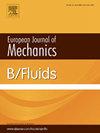Flow topology of the wake of a rotor and its relationship with the energy efficiency
IF 2.5
3区 工程技术
Q2 MECHANICS
引用次数: 0
Abstract
A numerical model is used to study the flow in the wake of a two-bladed horizontal-axis rotor. The flow topology is analyzed for three different angular velocities of the rotor. For the fastest rotor there is a region downstream where the fluid loses nearly 30% of the axial inflow velocity, whereas almost 60% is lost if this region belongs to the wake of a second-in-line rotor. The second part of this study deals with the evolution of the tip helical vortices in the presence of a turbulent inflow wind. This is found to destabilize the vortices, which subsequently perform a leapfrogging motion. As the turbulence of the inflow wind strengthens, the leapfrogging starts closer to the wind rotor. If a second-in-line rotor is located in this wake, the power it extracts from the wind depends on its location with respect to the point where the first rotor’s vortices become unstable. A second rotor located downstream of this point extracts more power than one located upstream of this point.
转子尾迹的流动拓扑及其与能量效率的关系
采用数值模型研究了双叶片水平轴转子的尾迹流动。分析了转子三种不同角速度下的流动拓扑结构。对于速度最快的转子,在下游有一个区域,流体损失了近30%的轴向流入速度,而如果该区域属于二线转子的尾迹,则损失了近60%。本研究的第二部分讨论了湍流流入风存在下尖端螺旋涡的演化。研究发现,这将破坏涡流的稳定性,使其随后进行跳跃式运动。随着入流风湍流的增强,越级开始靠近风转子。如果第二转子位于尾流中,它从风中提取的能量取决于它相对于第一转子的旋涡变得不稳定的位置。位于该点下游的第二个转子比位于该点上游的转子提取更多的功率。
本文章由计算机程序翻译,如有差异,请以英文原文为准。
求助全文
约1分钟内获得全文
求助全文
来源期刊
CiteScore
5.90
自引率
3.80%
发文量
127
审稿时长
58 days
期刊介绍:
The European Journal of Mechanics - B/Fluids publishes papers in all fields of fluid mechanics. Although investigations in well-established areas are within the scope of the journal, recent developments and innovative ideas are particularly welcome. Theoretical, computational and experimental papers are equally welcome. Mathematical methods, be they deterministic or stochastic, analytical or numerical, will be accepted provided they serve to clarify some identifiable problems in fluid mechanics, and provided the significance of results is explained. Similarly, experimental papers must add physical insight in to the understanding of fluid mechanics.

 求助内容:
求助内容: 应助结果提醒方式:
应助结果提醒方式:


